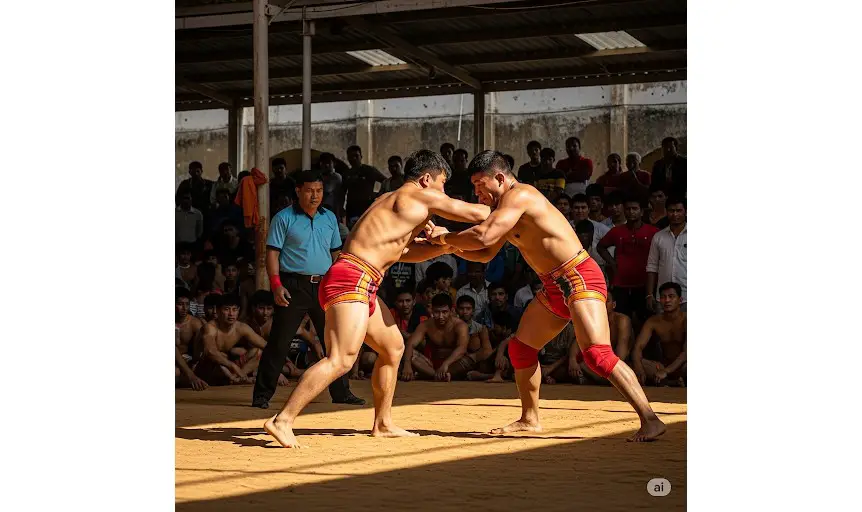
Exploring the Rich World of Pehlwani: A Traditional Sport
Pehlwani, an ancient form of wrestling, is deeply embedded in the cultural and historical fabric of South Asia. Its roots stretch back centuries, intertwining with traditions, myths, and rituals that have shaped the region’s identity. The sport has evolved over time, gaining recognition far beyond its birthplace. Today, Pehlwani enjoys a dedicated following worldwide, captivating enthusiasts with its blend of physical prowess, discipline, and spiritual undertones. This blog delves into its origins, global popularity, amateur participation, professional leagues, societal significance, and rules.
The Origin and History of Pehlwani
The origins trace back to ancient India, where it was known as “Malla-Yuddha.” Historical texts and sculptures depict wrestlers engaging in this combat sport, emphasizing strength, technique, and honor. The sport flourished during the Mauryan and Gupta empires, where wrestlers were esteemed figures.
With the advent of Mughal rule in India, Persian influences began shaping Malla-Yuddha, giving rise to Pehlwani. Persian wrestling practices, combined with local traditions, led to the creation of this distinct sport. The word “Pehlwani” itself derives from the Persian word “Pahlavan,” meaning a champion or hero.
Pehlwani gained further prominence during the colonial era. Indian wrestlers, known as pehlwans, were pitted against international opponents, showcasing their skills on a global stage. Legendary figures such as Gama Pehlwan, often referred to as “The Great Gama,” brought unprecedented fame to the sport.
Today, the legacy of Pehlwani endures. It is celebrated in akharas (wrestling schools) across India, Pakistan, and beyond. The sport remains a symbol of resilience, cultural pride, and physical mastery.
Global Popularity of Pehlwani
While it originated in South Asia, its appeal has transcended borders. Indian and Pakistani diaspora communities have played a crucial role in spreading the sport globally. Wrestling enthusiasts from countries like the United States, Canada, and the United Kingdom have embraced Pehlwani, establishing training centers and hosting tournaments.
It is particularly popular in regions with significant South Asian populations. For instance, cities like Toronto, London, and New York regularly host events celebrating this traditional sport. Moreover, international wrestling federations have incorporated elements of Pehlwani into their training programs, recognizing its value in enhancing wrestling techniques.
In addition, cultural festivals often feature Pehlwani demonstrations, drawing attention to its rich heritage. These events attract audiences from diverse backgrounds, fostering cross-cultural appreciation and understanding.
Amateur Pehlwani: Youth and Schools
The foundation of Pehlwani lies in its grassroots initiatives. Akharas, often located in rural areas, serve as training grounds for aspiring wrestlers. Young boys, sometimes as early as five years old, begin their journey under the guidance of experienced gurus or ustads.
In many parts of India and Pakistan, schools and community centers promote it as an extracurricular activity. These programs emphasize physical fitness, discipline, and mental resilience. Youth tournaments provide a platform for young pehlwans to showcase their skills and gain recognition.
Furthermore, modern initiatives aim to integrate Pehlwani into school curriculums. By doing so, they ensure the sport’s continuity and inspire the next generation. Internationally, South Asian communities have also introduced Pehlwani clubs for children, fostering a sense of cultural identity.
Professional Leagues Associated with Pehlwani
Professional Pehlwani leagues are gaining traction, offering structured platforms for elite wrestlers. In India, events like the Kushti Mahotsav bring together top-tier talent, drawing large audiences. These tournaments often feature cash prizes, trophies, and widespread media coverage.
Pakistan, too, hosts prestigious Pehlwani competitions, particularly during festivals such as Basant and Eid. Wrestlers compete in front of enthusiastic crowds, showcasing their prowess and dedication.
Beyond South Asia, international wrestling organizations have started recognizing Pehlwani’s potential. Mixed martial arts (MMA) promotions often feature athletes with Pehlwani backgrounds, highlighting its relevance in modern combat sports. Wrestlers with Pehlwani training have achieved notable success in global arenas, further elevating the sport’s profile.
Political and Social Significance
Pehlwani is more than just a sport; it is a cultural phenomenon. Historically, it symbolized resistance and defiance against colonial powers. Indian freedom fighters often emphasized physical training, including wrestling, as a means of empowerment.
Socially, Pehlwani fosters a sense of community and brotherhood. Akharas serve as spaces where individuals from diverse backgrounds come together, united by their love for the sport. These centers promote values like humility, respect, and dedication.
In contemporary times, it continues to play a role in addressing societal issues. Initiatives aimed at empowering marginalized communities often include wrestling programs, providing opportunities for personal and professional growth. Additionally, female wrestlers have begun making their mark, challenging traditional gender roles and inspiring change.
Rules of Pehlwani
The rules emphasize technique, strength, and respect. Matches take place in circular mud pits, prepared with a mixture of clay, water, and oil. Wrestlers wear traditional loincloths called langots.
A match begins with a ceremonial greeting between opponents, reflecting mutual respect. The objective is to pin the opponent’s shoulders to the ground or force them into submission. Striking is prohibited, focusing solely on grappling techniques.
Time limits vary depending on the level of competition. Amateur matches typically last between five and ten minutes, while professional bouts can extend longer. Referees ensure fair play, enforcing rules and resolving disputes.
Training plays a crucial role. Wrestlers follow rigorous regimens, including strength training, yoga, and specialized diets. The emphasis on holistic development distinguishes Pehlwani from other wrestling styles.
Conclusion
Pehlwani, with its rich history and cultural significance, continues to inspire generations. Its global appeal, fueled by diaspora communities and international recognition, underscores its universal relevance. Whether practiced in rural akharas or professional arenas, it embodies the values of discipline, perseverance, and respect. As the sport evolves, it remains a powerful testament to the enduring spirit of wrestling traditions. By exploring Pehlwani, one gains a deeper appreciation for the interplay between culture, sport, and identity.




